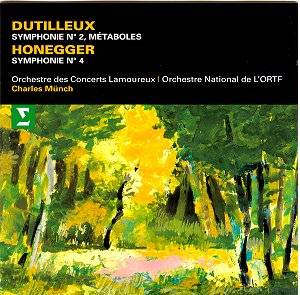Charles Münch conducted the first performance
of Dutilleux’s Second Symphony in December 1959 with the Boston
Symphony Orchestra who had commissioned the work. Münch considered
that his life’s mission was to champion new music. He remakred
that: "the music of our century is an expression of the preoccupations,
anxieties and trends of the world we live in and we ought to listen
to it ... and become acquainted with new harmonies and forms."
He valued the colourful and kaleidoscopic music of Dutilleux highly.
From this reviewer’s point of view, his music is very approachable,
there is always something to interest and hold my ear.
In his Second Symphony, Dutilleux divides the
orchestra into two unequal groups to experiment with sonorities
and their spatial distribution, in something of a game of mirrors.
The music constantly shifts in focus and substance, moods changing
constantly and spontaneously, at once gloomy, then bright, then
classical then grotesquely cartoon-like, then jazz-inflected and,
in the third movement, remote and celestial. You sense parodies
of the styles of Richard Strauss and over-blown late Romanticism
in general, of Bernard Herrmann, of George Gershwin, and of Stravinsky
to name but a few.
Dutilleux’s Métaboles is a kind
of concerto for orchestra in which a different section of instruments
comes under the spotlight in each section. There are five movements
‘Incantatoire’, ‘Linéaire’, ‘Obsessionnel’ ‘Torpide’ and
‘Flamboyant’, each title giving a clue as to the general mood.
‘Torpide’ for instance with its brushed cymbal strokes, languid
brass and ascending chattering woodwinds suggesting swarms of
insects, might be a sultry portrait of the tropics.
Honegger’s Second and Third Symphonies had been
premiered by Münch but he did not feel much drawn to the
Fourth. This more serene Symphony with the Latin subtitle "Deliciae
basilienses" (The Delights of Basel) was commissioned for
the 20th anniversary of the foundation of Paul Sacher’s
Basel Chamber Orchestra. It is a fitting companion to the Dutilleux
works in this compilation. Again the textures and colours hold
the ear. There is something oriental about the work as well as
French-pastoral atmospheric - snatches of birdsong and vigorous
folksong - plus Swiss melody associated with the city of Basel.
The skilfully crafted orchestral texture is extremely transparent
and the polyphony joyous.
Fine committed performances of very approachable
modern music. The Dutilleux especially is very colourful, kaleidoscopic
and quite addictive.
Ian Lace
